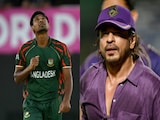Mari Selvaraj's Pariyerum Perumal (2018) is an incendiary caste drama. Pariyerum Perumal, the titular protagonist, belongs to an oppressed caste. When he joins law college in the city, challenges mount. Inside the classroom, he struggles with English, and outside, with identity. He finds solace in the company of Jothi Mahalakshmi, an upper-caste girl who helps him. Friendship blossoms. Using this tender chord, Selvaraj crafts a persuasive commentary on caste-based subjugation where the hero undergoes hurt and shame only to reckon that the stratified society not just prohibits him from falling in love but holds out the right to know if he can love, at all.
The Emergence Of Vidhi
In Dhadak 2, Shazia Iqbal adapts the Tamil film with visible shifts. The core remains the same, the anti-caste commentary is denoted with attentive care, but the gaze widens. In her retelling, a Dalit student leader is lent prominence who, unlike the diffident protagonist Neelesh Ahirwar (Siddhant Chaturvedi), is strident and informed. He has the eloquence of real-life activists and shares the tragic fate of students like Rohith Vemula. It is an explosive addition to the original material, a reformation of sorts as the story transitions to another language and moves from Tamil Nadu to Madhya Pradesh. The filmmaker does something else too - crafts an agential female character.
Jothi in Pariyerum Perumal is a cog in Pariyerum's journey. She is a bystander, rendered mute by her family and the narrative. Her presence initiates the man's journey into self-realisation, and as the film unfolds, her role remains limited to that. There is a broad unawareness to her, extending from innocence about her family's degradation of Pariyerum to ignorance about caste-based ostracism. Her dented social and intellectual capacity makes her existence non-existent. In theory, it works by focusing the attention on Pariyerum without distraction. But it also undercuts her truth, firmly establishing, therefore, Pariyerum Perumal as the story of a single man.
When A Woman Has Stakes In The Story
Iqbal and Rahul Badwelkar (writers of Dhadak 2) make substantial changes in this regard. Vidhi Bharadwaj (Triptii Dimri) has a stake in the story. Her reality of studying in law school is not just a plot detail, it has tangible consequences. When her elder sister's marriage is fixed and the elders in both families talk about matching caste (both upper caste) as part of the arrangement, she intervenes to ask about the relevance of it. This informed sensibility impedes her from being a spectator in a story that offers centerstage to prejudices.
Her rebellion sharpens when she meets Neelesh. They see each other at a wedding (he plays the dhol and she is one of the invitees) but meet at college, as students. The space offers them an equal footing, albeit presumably, and they are swept away. If Pariyerum Perumal was headlined by a man who was broken before he could know if he was in love (or not), then the male lead in Dhadak 2 falls in love only to be made aware that he was not supposed to. Realisation awaits both; for Neelesh, it comes a little late.
This Is Not Really A Love Story
The first half of Dhadak 2 unfolds as a love story where caste does not take a backseat but looks surmountable. Much of it comes down to Vidhi. She stands tall next to Neelesh. When a professor tries shaming him, she counters it (the same scene exists in the Tamil film, with the exception of the girl grudgingly partaking in it). When he hesitates to hold her, she holds his hands; later, when asked why she broke up with her ex-boyfriend, Vidhi reasons, "toxic masculinity". Her support only strengthens as attacks on him get aggressive. She calls out her cousin (a common upper-caste offender in both films) and refuses to be sidelined when the men fight among themselves.
In theory, it is a radical course-correction. With Vidhi, Iqbal puts forth a female character with a mind of her own. She is socially informed and intellectually conscious. Her cognisance fulfills the possibility of Dhadak 2 being a love story, where the responsibilities are shared because the fight assumes equality. Her gender is not sidestepped as an initiator to a man's story but informs her empathy, wherein she stands up for the persecution of someone else. She is situated at the extreme end of a spectrum whose other side is occupied by someone like Jothi from Pariyerum Perumal. And yet, they meet.
A Complex Portrait
Vidhi is strong and reasonable. She has agency, but with limitations - a reading that the film reiterates in its runtime. Unlike someone like Neelesh, who lives with caste inequality, Vidhi has merely read about it. Dhadak 2 does not draw equivalence, but if the love story in the first half carries this inkling in spirit, then the second half squashes it. As Neelesh is relentlessly attacked by the upper-caste boys in the college and is told to stay away, Vidhi gets increasingly incensed. She matches shoulders with him, yet Iqbal's film resists portraying her rebellion as fruitful.
Scenes of her fighting with her cousin and sister end with little resolution. Something similar happens when, in a marked departure from the source, Vidhi is told about her father's complicity in Neelesh's humiliation. In the original, Jothi remained in the dark till the end, a shielding gesture almost from the maker. Iqbal, in contrast, takes the plunge. Yet, the confrontation never comes. Vidhi bristles with agitation, promises to ask her father, but ultimately, doesn't.
These keep adding up to craft a complex portrait of a female protagonist whose rebellion is not insincere but restricted. Her existence is mired with compassion but also propped up by privilege. Ideologically, she might be distinct from someone like Jothi, who does not see caste distinctions, but they unite in the freedom to see through it. If one has caste blindness, then the other is caste agnostic (when Neelesh confides that his dog was brutally killed as a casteist act, she expresses surprise that such things still happen). When the full force of his reality befalls Neelesh, he crumbles and retreats; he is asked to stay away and he accedes. But she refuses. She visits him, and appears to be in daze when he shows her his neighbourhood - a ghettoised area and far cry from her two-storeyed house. In Vidhi's eyes, trained by watching Hindi films, social issues can be beaten with love.
Foresight, With Blindspots
But Dhadak 2 is not a love story; it is a story informed by love. Iqbal uses the familiar trappings - songs, family opposition, overwhelming odds - only to reinforce the critique. Vidhi behaves like a plucky girl in love because she can. The stakes for her are considerably less even when the intent is genuine. She is protective and accommodating towards a man from an oppressed caste but she is also protected and accommodated by her upper-caste family. She opposes a biased professor in college but fails to recognise the biases breeding in her father at home. Her foresight is dotted with blindspots. Neelesh, however, has clarity because he's fighting for something that Vidhi has as a birthright: dignity.
But someone like Vidhi underlines the invisible caste advantage that love stories stand on and perpetuate. Her behaviour, imitative and liberated, draws focus to the leverage Hindi films inadvertently bestow on protagonists by being in denial of hierarchies. Most narratives remain quiet on surname identities because it is taken care of by the makers and the advantage, albeit silent, allows characters to fight other battles. Iqbal refuses to look away. In a film about discrimination and entitlement, she acknowledges the social elevation that someone like Vidhi possesses and her curiosity. By doing so, the filmmaker births a rare female character who resists binaries: she is neither a victim nor a saviour, neither ignorant nor enlightened. Vidhi is flawed and rebellious, because she has the privilege and autonomy to be both.
(Ishita Sengupta is an independent film critic and culture writer from India. Her writing is informed by gender and pop culture and has appeared in The Indian Express, Hyperallergic, New Lines Magazine, etc.)
Disclaimer: These are the personal opinions of the author















